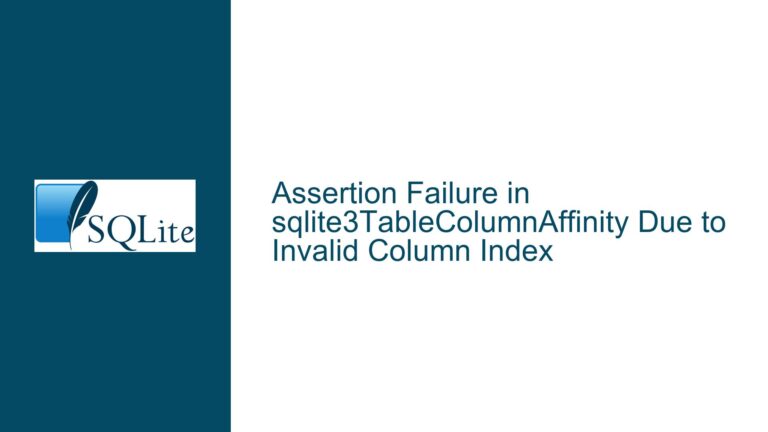SQLite View Column Affinity: Converting SUM Result to REAL
Understanding Column Affinity and Expression Results in SQLite Views
SQLite’s type system operates on a unique principle called type affinity, which differs significantly from traditional strongly-typed database systems. When dealing with views that contain aggregate functions like SUM(), the resulting column’s type affinity becomes a critical consideration for data consistency and application behavior. The core challenge emerges when aggregate functions in views produce results with NONE affinity, potentially causing unexpected type conversions or comparison behaviors in downstream operations.
The type affinity system in SQLite serves as a mechanism for determining how values should be stored and compared. While base tables can explicitly declare column affinities through their CREATE TABLE statements, expressions and function results in views follow different rules. Aggregate functions, including SUM(), return results with NONE affinity, which means SQLite will not attempt to coerce values into any specific storage class.
The implications of NONE affinity in view columns extend beyond mere storage considerations. When applications interact with views containing aggregate calculations, the absence of a specific type affinity can lead to inconsistent behavior, especially when these values are used in comparisons, joins, or further calculations. The storage class of the actual values remains numeric, but without the beneficial type coercion that REAL affinity would provide.
Dynamic Type Resolution and Aggregate Function Behavior
SQLite’s dynamic type system introduces several complexities when handling aggregate function results in views. The fundamental behavior stems from SQLite’s internal type resolution mechanisms, which process aggregate functions differently from simple column references or basic expressions.
When an aggregate function like SUM() operates on a column with REAL affinity, the function itself preserves the numeric nature of the calculation but strips away the original column’s type affinity. This behavior is rooted in SQLite’s design philosophy of dynamic typing, where expression results are treated with maximum flexibility. The aggregate function’s output maintains its numeric characteristics for mathematical operations but loses the strict type coercion rules that would normally apply to REAL columns.
The type resolution process follows a specific sequence when evaluating expressions in views:
- The base column’s affinity (REAL in the case of future_price) influences the initial data reading
- The aggregate function performs its calculation, maintaining numeric precision
- The result is generated with NONE affinity, regardless of the input column’s affinity
- Any subsequent operations or comparisons work with the raw value without type coercion rules
This behavior can impact performance and data consistency, particularly when the view’s results are used in complex queries or when strict type comparisons are required. Applications expecting consistent REAL affinity behavior might encounter subtle issues when working with these aggregate results.
Implementing Type Affinity Control and Optimization Strategies
The solution to controlling column affinity in view results involves explicit type casting and careful consideration of query structure. The CAST function provides the primary mechanism for enforcing specific type affinities on expression results within views.
To implement proper type affinity control, the view definition should be modified to include explicit type casting:
CREATE VIEW test1111 AS
SELECT
t_spotprice.*,
CAST(SUM(future_price) AS REAL) as fp2
FROM t_spotprice
WHERE tradingday = 20200103;
This approach offers several advantages:
The CAST operation enforces REAL affinity on the aggregate result, ensuring consistent type behavior throughout the application. The casting operation maintains numeric precision while providing predictable type coercion rules for subsequent operations. The view’s output becomes more reliable for type-sensitive operations and comparisons.
For optimal performance and reliability, several additional considerations should be implemented:
The base table’s column definitions should maintain clear and appropriate type affinities. The tradingday column, currently defined as TEXT(20), might benefit from a more specific type definition depending on the application’s requirements. The length specifiers in TEXT column definitions (TEXT(20) and TEXT(30)) are actually ignored by SQLite and could be removed for clarity.
When working with the modified view, applications should consider the following optimization strategies:
The WHERE clause on tradingday should ideally match the column’s storage format to avoid type conversion during filtering. If tradingday values are consistently formatted as integers (like 20200103), considering changing the column’s type affinity to INTEGER might improve query performance.
Index optimization becomes crucial when the view is frequently queried:
CREATE INDEX idx_spotprice_tradingday ON t_spotprice(tradingday);
For complex queries involving the view, materialized results might be beneficial:
CREATE TABLE materialized_test1111 AS
SELECT
t_spotprice.*,
CAST(SUM(future_price) AS REAL) as fp2
FROM t_spotprice
WHERE tradingday = 20200103;
The materialized approach can significantly improve query performance when the underlying data changes infrequently, though it requires manual maintenance to stay synchronized with the base table.
To ensure optimal performance and reliability, applications should implement proper error handling and validation:
-- Validation query example
SELECT typeof(fp2) as result_type
FROM test1111
LIMIT 1;
This validation helps confirm that the type casting is working as expected and the view is returning results with the correct affinity.
The complete solution should also consider transaction handling when the view is used in write operations:
BEGIN TRANSACTION;
-- Operations using the view
SAVEPOINT pre_view_operation;
-- Complex operations involving the view
COMMIT;
This approach provides atomicity for operations that combine view queries with data modifications, ensuring data consistency across related operations.
Regular maintenance procedures should include reanalyzing the view’s performance:
ANALYZE test1111;
This helps SQLite maintain accurate statistics for query optimization involving the view.
By implementing these comprehensive solutions and following the outlined optimization strategies, applications can maintain consistent type behavior while maximizing performance and reliability in SQLite view operations involving aggregate functions and type casting.






